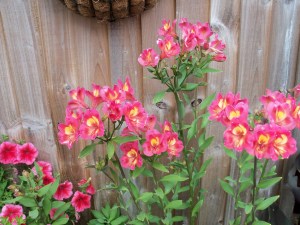(Botanical name: Alstroemeria. A tuberous hardy perennial originating from South America) (Common name: Peruvian lily.)

It’s only in recent years we’ve come across Alstroemerias. I’d seen them as artificial flowers, always thinking they were a made-up plant, until the day my husband brought me home a fresh bouquet of them. They were in tight bud and have to admit, at first I was not impressed. However, they slowly unfolded to reveal beautiful blooms which lasted for over 3 weeks. We decided to buy some to grow in the garden and glad we did. They perform wonderfully, need little fuss and attention and keep on giving.
Although commonly called a “lily”, they are not bulbs, but tubers. Having been advised they are problematic to grow from these, or seed, we purchased several established plants from our favourite independent garden centre some miles away — always a lovely drive, a weekly day out in normal times.
Alstroemeria come in many species and varieties (at least 1,260!) and colours, so an endless choice with some varieties also have perfume, others with varigated leaves Take a look on the RHS website to see the huge range. They are definitely plants I shall grow more of. One in particular I am after, called Indian Summer, has dark reddish/bronze leaves, and yellow flowers with a reddish centre.

Those we bought were planted in various locations around the garden and in pots to see how they would perform in each, be it shade, semi-shade or full sun. To our delight, they thrived wherever we put them. Those growing directly in the garden were left to die down last autumn, and all came back. Those planted in pots were taken into the greenhouse to overwinter; again, all thrived. We’ve experienced high winds this summer and several of the stems have blown over so next year I will ensure those in the borders are staked, as they grow quite tall.

Most varieties grow tall, anything up and over a 1m high, so are perfect for the back and middle of the border, whilst other varieties are dwarf, some only to about 25—30 cm and look great in pots. Flowering from May to September, looking after is easy with regular watering, especially in dry spells, feeding once a week (we always use Miracle-Gro). Once each stem has finished flowering, deadhead by simply pull the whole stem out from the base, it should come away easily, if it doesn’t leave it for a day or two then try again. New flower stems will swiftly grow, keeping the plant in flower for months. Next Spring we will divide them to create more.

Another bonus is they are marvellous as a cut flower, lasting several weeks, changing the water every 5-6 days.
Tip: As I do for any cut flowers, I always put a few copper coins into the water, an old florist’s trick I learnt) to help them last longer. I don’t know the science behind it but it works miracles with tulips especially, keeping them upright, and even straightens those stems that have flopped, as tulips love to do!
A favourite of mine as well, you have reminded me to get some more for next season.
LikeLiked by 1 person
Yes, a firm favourite of mine now. Still have some in bloom in the garden. Must pick them for indoors before the forecast winds hassle them. 🙂
LikeLike